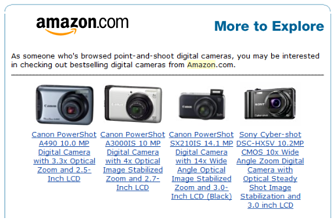I’ll be the first to admit that I’ve fallen victim to Amazon’s “recommended” products more than once.
Last week I opened Amazon to purchase some specialty dog food I can’t get at my local PetSmart, and before I knew it, I was deep in an online shopping hole reading reviews on a back-scratcher shaped like a bear paw. Two days later, it was at my doorstep (it’s glorious btw).
Why? It’s a long story – my friends have a running joke about bears, it’s not important. What is important is that Amazon knows this. Ok, maybe they don’t know the joke itself, but they do know that I’ve looked at various bear-related items in the past, and thus I’m much more likely to buy something similar. So even though I’ve never looked at bear paw back scratchers, searched for them, or even knew they existed, Amazon knew what I wanted, and I bought it.
I’m sure most of us that use Amazon are somewhat familiar with this phenomenon – the incredible accuracy with which Amazon can predict buying behaviors of its customers is nothing new.
The most easily recognizable example of this is Amazon’s “recommended” or “related” products. As stated in Amazon’s cookie policy: “We [Amazon] use cookies, pixels, and other technologies (collectively, "cookies") to recognize your browser or device, learn more about your interests, and provide you with essential features and services and for additional purposes….”
Basically, they track and store browsing and purchase data among many other data points to determine what our interests are and what we’re most likely to buy – and it works! It’s estimated that roughly 35% of Amazon’s sales come from “recommended” products, which translates into about $43.7 billion in revenue.
Another way Amazon uses its first-party data is through the use of email retargeting. If you were browsing Amazon for a digital camera but left without purchasing one, chances are you will receive an email within a few hours that looks something like this:

While Amazon has an estimated nine different types of personalized emails they send to their customers, their browsing history emails are the most applicable for this example. These are based on your browsing history and can include different types, colors, or brands of similar products to those you looked at before leaving the site.
How can B2B companies replicate Amazon’s success?
In all fairness, Amazon is one of the most straightforward examples I could have chosen for this, but for good reason – they have been able to harness their first-party data and leverage it to drive better conversion rates and more sales.
However, in terms of the products Amazon sells, they are a B2C company. It’s no secret that B2B marketers and salespeople face different challenges in the sales process. But we can apply some of the success Amazon has seen to the B2B sales process.
How to gather first-party data:
For B2B marketers, this is the easy part. Companies like KickFire can place a simple tag on your site that will gather all the first-party intent data you need. In addition, you can also see valuable company data like industry, revenue range, employee count, and more that you can use to power your sales and marketing programs.
How to use first-party data:
Website content personalization – If we can take one lesson from Amazon’s success, it’s this: customers want personalized shopping experiences, and B2B buyers are no different. By using platforms like Google Optimize and Adobe Target combined with your first-party data, you can personalize nearly every aspect of your website to better resonate with your target audience. Leveraging these technologies across your website allows you to customize things like welcome banners, images, copy, recommended content, and more. You can even go as far as to change your site’s navigation and entire pages to steer visitors from specific industries or sizes toward the different solutions you offer.

Email personalization – This is where things get a little different from the Amazon example. Amazon has access to all of its customer’s email addresses, allowing them to send out highly personalized emails automatically. However, unless your website visitors have voluntarily given you their email addresses, chances are you don’t have access to the emails of your website visitors. But don’t worry, all is not lost! Once you’ve identified a company that has visited and shown buying intent on your website, you can use platforms like Seamless.ai to gather a list of email addresses of the employees at that company. Now depending on what you sell, the list might be different. If you sell HR software, you want the HR department; if you sell sales software, the sales department, etc. Once you have this list, you can send out highly targeted emails that speak directly to the pain points that your products solve.
Dynamic retargeting ads – Retargeting ads can be a highly effective way to recapture visitors that have been to your website but have left without converting. While there are various retargeting outlets out there, for B2B marketers, one stands head and shoulders above the rest – Google. The Google Ads platform allows you to leverage your first-party intent data to dynamically adjust your ad bids based on things like:
- Whether or not a user has visited your website before
- If their company data matches your target audience
- If they are a competitive company
- And more.
The process of bidding up or down based on these factors can have a huge impact on the number and placement your ads get and can result in much higher conversion rates. In fact, a recent study by ReadyCloud showed that the average clickthrough rate for retargeted ads is 10x that of display ads, and in addition, customers who see retargeted ads are 70% more likely to convert on your website.
Key Takeaway:
While Amazon stands out as the gold standard for using first-party data to drive revenue, B2B marketers can use them as a model to emulate their success. By capturing first-party intent data across your website, you’ll get an in-depth look into which companies are in the market for your products while also gathering the valuable company data you need to power your ABM strategies. Leveraging this data to personalize content across your website, send highly targeted emails, and dynamically adjust your retargeting ad bids is just the beginning – with the right data at your fingertips, the possibilities for your team are endless.
